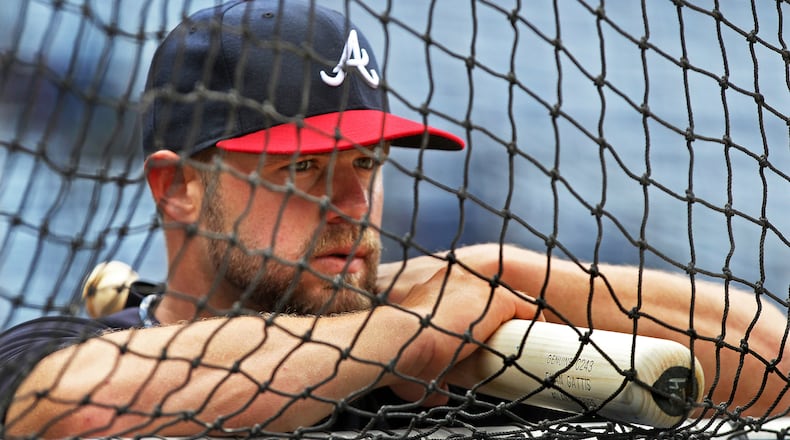The Braves selected and signed 23 players from the 1981 June amateur draft. None of them played in the major leagues. It was an extreme example of how hard it can be for MLB teams to determine which young prospects one day will be good enough to play in the major leagues.
It will be even harder over the next two years. In response to the novel coronavirus pandemic, MLB and the players’ union agreed to reduce the number of rounds in Wednesday’s draft from 40 to five. Undrafted players can receive a maximum $20,000 signing bonus and the 2021 draft is set to be cut to 20 rounds with the same bonus limit for players not selected.
The moves will save each MLB team only about $1 million this year, but that's part of a bigger picture. MLB reportedly wants to eliminate 42 of 162 minor-league affiliates. Franchise owners are facing a class-action lawsuit for paying minor players below minimum wage. It's inevitable MLB will have to increase those salaries, so reducing the number of minor-league players lessens the coming financial hit.
Baseball teams already are saving money by manipulating service time for prospects. Now they also want to squeeze more of them on the front end. Like many of baseball’s cost-saving moves, this latest scheme is short-sighted.
In each of the past 15 seasons more than 40 million people attended minor league baseball games. An affordable night at the ballpark is a way for fans to connect to the game. They can watch young players who one day will become major leaguers. Baseball develops fans along with players in the minor leagues.
But the bigger impact from cutting signing bonus money will be on the quantity of talent on the farm.
In last year’s draft, nearly 400 players selected after the sixth round received signing bonuses of at least $100,000. The $20,000 maximum bonus for undrafted players this year and next is a number that more athletes will reject. They’ll decide it’s better to join the workforce or play another sport rather than sign for $20,000 and make a paltry wage in the minors.
MLB teams are more confident than ever in the efficiency of their scouting and player development departments. FiveThirtyEight's Travis Sawchik makes the case that technological changes make teams better at identifying and developing lower-level prospects who are on the MLB track. Sawchick argues those players need to spend less time (or maybe no time) playing on minor-league teams filled with prospects who won't sniff the majors. Better to focus more resources on the best prospects.
I’m skeptical of the wisdom of that approach. There are intangible benefits to prospects playing on teams in real competition. It also might be the case that MLB teams are over-confident in their ability to develop prospects.
In 2017, Baseball America studied drafts from 1981 to 2010. In that sample, about 70% of first-round picks and 55% of supplemental picks went on to play in the majors. The next three rounds got good returns: 50% of prospects selected in the second round made it, 40% in the third round, and roughly 30% in the fourth and fifth rounds.
It gets more difficult to find future major leaguers in the later rounds, but teams hit on a significant number of them. More than 20% of players in Baseball’s America sample drafted in rounds 5-7 played in the big leagues. About 20% of prospects selected in rounds 8-10 did so.
The Braves have had some luck with late-round draft picks over the years. According to my research of Baseball Reference data, from 1981 to 2011 the Braves drafted and signed 89 players later than the fifth round who made it to the majors.
Most of those players were with the Braves for a short time. Others had brief stops in the majors with other teams after the Braves traded them, released them or left them unprotected to be selected in the Rule 5 draft. But a few players the Braves drafted after the fifth round produced a huge return on investment by becoming reliable MLB regulars or standouts.
You may recognize the names:
- Infielder Mark Lemke (27th round, 1983) played 10 of his 11 MLB seasons with the Braves and was one of their best hitters during the 1991 World Series.
- Reliever Mike Stanton (13th round, 1987) pitched for the Braves for seven of his 19 years.
- Kevin Millwood (11th round, 1993) was a great starter for the Braves in 1999 and pitched in the majors until 2012.
- Mark DeRosa (seventh round, 1996) was a Braves utility man for four seasons before becoming a good regular with the Rangers and Cubs.
- Marcus Giles (53rd round, 1996) was a Braves All-Star in 2003.
- Left-hander Jonny Venters (30th round, 2003) was an All-Star in 2011 and good again during a 2018 comeback after three Tommy John elbow surgeries.
- Tyler Flowers (33rd round, 2005) broke in the majors with the White Sox before returning to become a regular catcher for the Braves over the past four seasons.
- Tommy Hanson (22nd round, 2005) appeared headed for stardom before health issues derailed his career.
- Right-hander Kris Medlen (10th round, 2006) came back from elbow surgery to have two very good years as a Braves starter.
- Catcher Evan Gattis (23rd round, 2010) was a Braves folk hero before going on to win a (since tainted) World Series with the Astros.
Those players are outliers among late-round draft picks. The vast majority of such players never make it to the majors or don’t stay there if they do. But more late-round picks stick in MLB than you may think.
In 2017 the Society for American Baseball Research studied how many players drafted and signed from 1996 to 2011 played in MLB for more than three years. About 10% of players drafted in rounds 6-8 did so. Roughly 8% of players selected in rounds 9-10 and 5% percent of players picked in rounds 11-20 played in MLB for three-plus years.
MLB teams eliminated those rounds in this year’s draft. Players who would have been drafted that late will be offered much smaller signing bonuses. Next year, players who aren’t selected in 20 rounds also will be offered bonuses of no more than $20,000.
Those signing restrictions for two waves of prospects likely will create a shallower talent pool. Expect that trend to continue given MLB’s desire to have fewer minor league players on payrolls. Teams will save money but hurt baseball’s growth.
About the Author
The Latest
Featured

